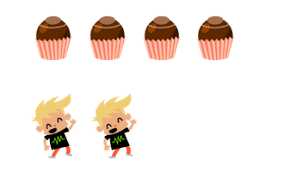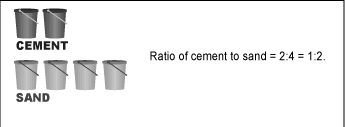Dilations, Ratios, and Proportions
Ratios
There are four cupcakes for two boys. How many cupcakes does each boy get? Each boy gets two cupcakes. If we had 3 boys and 6 cupcakes, each boy would still get 2 cupcakes because all the ratios can be reduced to 2:1. All the ratios, 2:1, 4:2 and 6:3 are equal.
Cupcakes to boys

Ratios
Let's say I hired you to pour a sidewalk from my doorway to my driveway. The directions on the bag of powder cement you bought says you will need to make a mixture of water, sand and cement powder. For every 2 bags of cement, you will need to add 4 bags of sand.
Cement to Sand

I could make a smaller batch of cement mixture by using one bucket of cement powder and two buckets of sand.
Proportions
A proportion is the number of parts to a whole. For example, in order to make one batch of cement mixture I need 2 buckets of cement powder and 4 buckets of sand.
one whole batch = 2:4
The powder and sand are the parts that make up the whole batch of cement mixture.
![[size=200][b][color=#ff0000]To eat a healthy meal, follow the recommended proportions of food groups. [/color][/b][/size]](https://stage.geogebra.org/resource/nmwwpjge/mw6xcEd4RLGrltCH/material-nmwwpjge.png)
Dilation
Notice that when the scale factor is less than one (SF < 1), the image gets smaller. When the scale factor is greater than one (SF > 1), the image gets larger. When the scale factor is equal to 1 (SF = 1), the image is the same size.
![[b][size=150][color=#0000ff]A dilation can result in a smaller image, or a larger image depending on the [/color][size=200][color=#ff0000]scale factor[/color][/size][/size][/b]](https://stage.geogebra.org/resource/wthg53yy/qqdrfkBSrk81pnrb/material-wthg53yy.png)
Scale Factor
![[b][size=200][color=#ff0000]A scale factor tells us how many times larger or smaller our image dilates. [/color][/size][/b]](https://stage.geogebra.org/resource/ru9jfcrz/IDoKNiPwVPWaaYYd/material-ru9jfcrz.png)